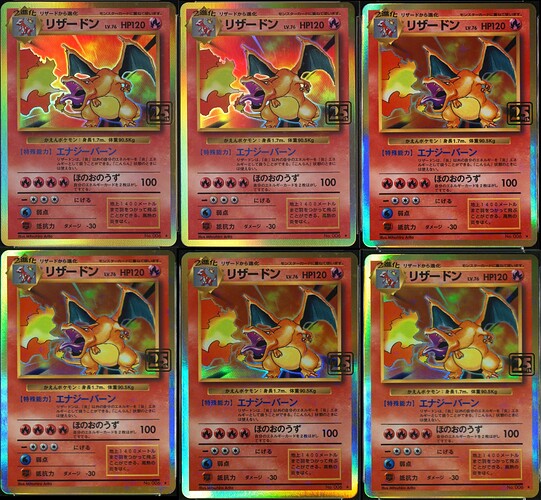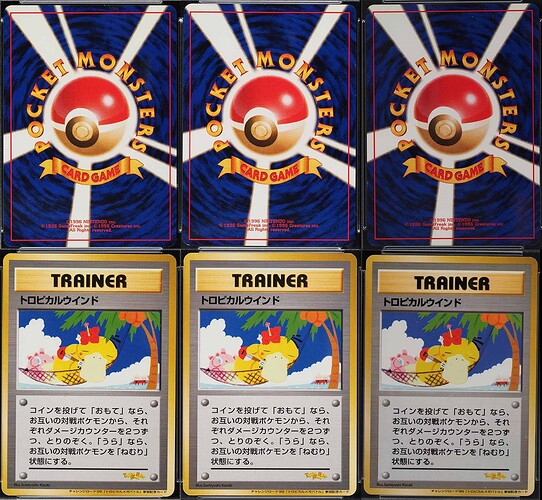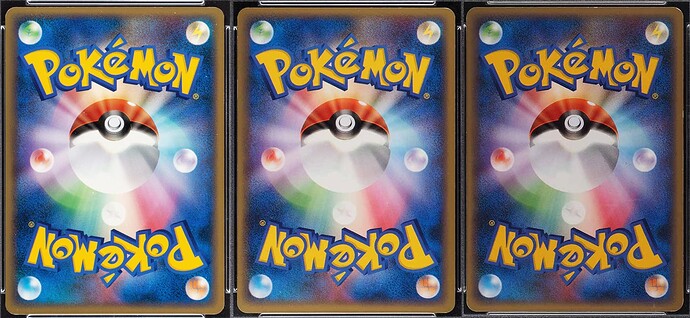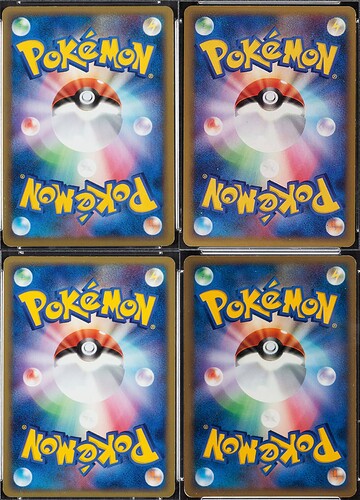- edited thread title before any more people reply to that instead of the post oops
I have a lot of salty thoughts about grading standards and I must rant. Open images below in a new tab for higher resolution.
We’ll start with Charizard from the 25th Anniversary Creatures Corporate Deck. I think this is a prime example because
- The print of every single card is nearly identical because it is such a limited print run.
- It is a very recent release and thus all copies have been graded within a (relatively) short window, negating any issues of grading standards changing over time.
- The print quality is very good in terms of surface and edges, but pretty much every copy is OC in the same way.
- Presumably every graded copy went straight from the deck to PSA; it’s not like a card that may have accumulated other damage over 20+ years.
So, below we have a few 9’s and a few 10’s. Since the surfaces and edges of every card are pretty much pristine out of the box, the distinction comes down to centering. Can you tell which is which? Don’t bother measuring the borders, as that will yield the wrong answer. As a bonus, 2 of the cards pictured below are the same copy - originally graded a 9, and then resubmitted and graded a 10. Can you find it?
The total PSA population for this card is 11. Of those 11, there are 5 that received a 10 grade. At least 2 of those 5 were originally graded a 9 and then resubmitted.
Now, I don’t really care if PSA wants to call the centering a 9 or a 10, but it can’t be this Schrodinger’s Zard bullshit on a card with such a consistent print run. It costs $2000 to have this card graded by PSA. Two thousand. At that price tier, there could be a rubric tailored for the individual card to assure consistency for the very few copies that will ever come in for grading. Instead, the scrutiny is the same as submitting at the $18 tier - which is to say, not much.
Moving on to another card with a limited and consistently flawed print run, let’s take a look at 1999 Tropical Wind. We know that pretty much every copy is OC and has corner chipping. Below we have a PSA 8, 9, and 10. Can you tell which is which?
This card has a total PSA graded population of 79, and is pop 3 (three) in a PSA 10. Would any of those 10’s receive the same grade if they were cracked and resubmitted? How much of total population is just a regrade of the same copy?
Moving on from consistent print issues, let’s take a look at some misgrades with respect to damage instead.
Three master’s scroll 10’s (total pop 58, 10 pop 26)
A couple Master’s Key 9’s (total pop 17, 10 pop 10), a Pika ring 10 (total pop 27, 10 pop 19), 2003 Victory Orb 10 (total pop 19, 10 pop 17):
And on and on and on. I won’t bother delving into more common items like JP Base and Gold Stars, as there are just too many examples to list, and it doesn’t inspire quite the same levels of salt that I have when I see it on “rare” cards.
I don’t know why label buyers are the way they are, but a 10 that looks like a 6 still typically sells for more than an actually “gem mint” 9.5 copy. Grading standards are broken and there’s really no incentive for PSA to do anything about it, as people will keep paying a premium for a label and people will keep submitting cards to PSA to chase that premium.
This isn’t all to say that grading is completely worthless. I really don’t care what a label says for my personal collection, but it still has value on the market side of things. Even if there are inconsistencies, having some kind of baseline condition expectations set by the number makes things easier for both the buyer and the seller, and marketplaces like PWCC just couldn’t exist in their current form at all without graded cards.
In conclusion: I’m mad
Cert numbers in order for the cards featured in this post if anyone that wants to look into them more: 63679084, 63714238, 64299132, 64579890, 64993708, 64999010
65562847, 63543202, 27353838
28490886, 26227277, 40691533
49425820, 63108288, 63134108, 28490890
Scans courtesy of PSA, PWCC, and Heritage.



